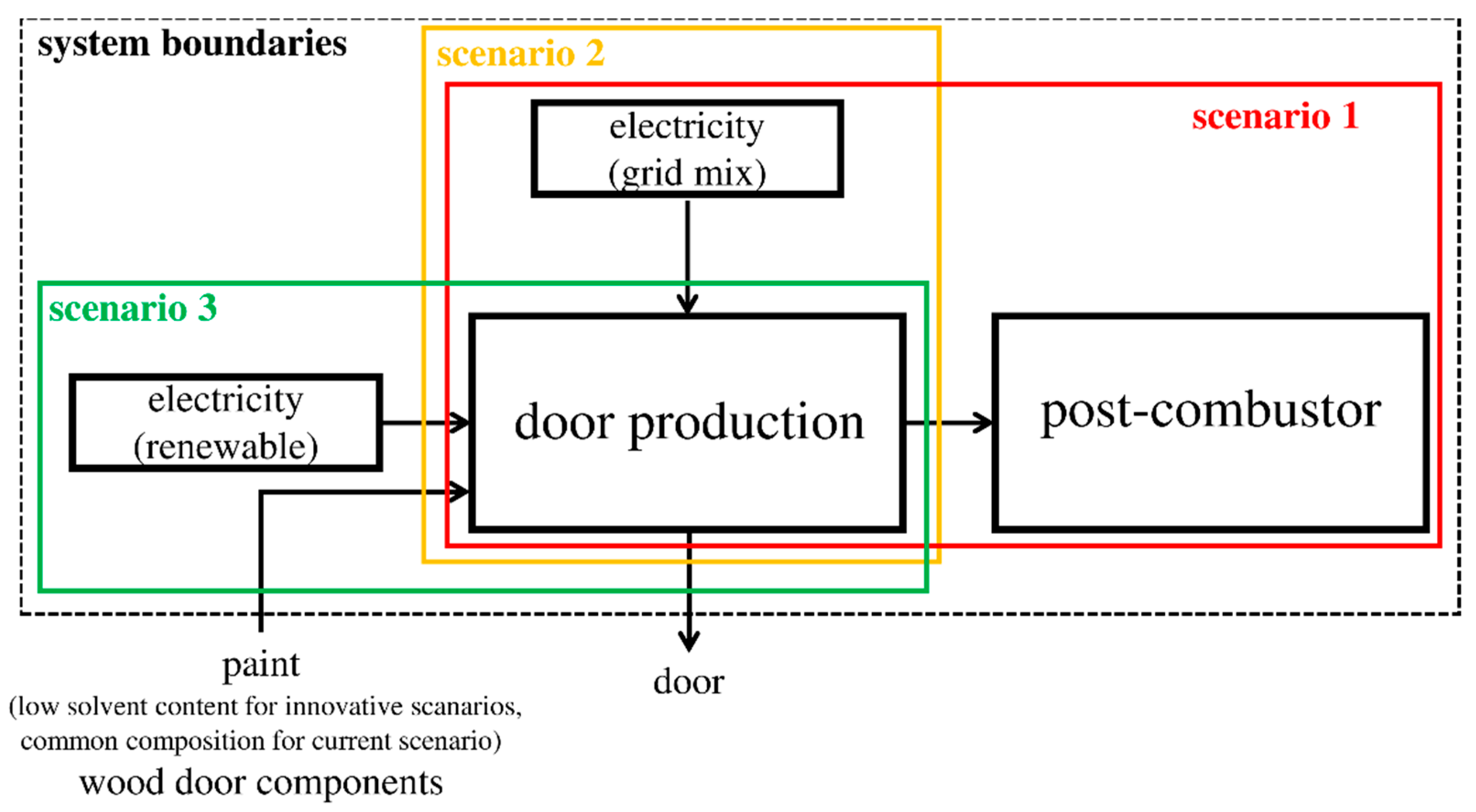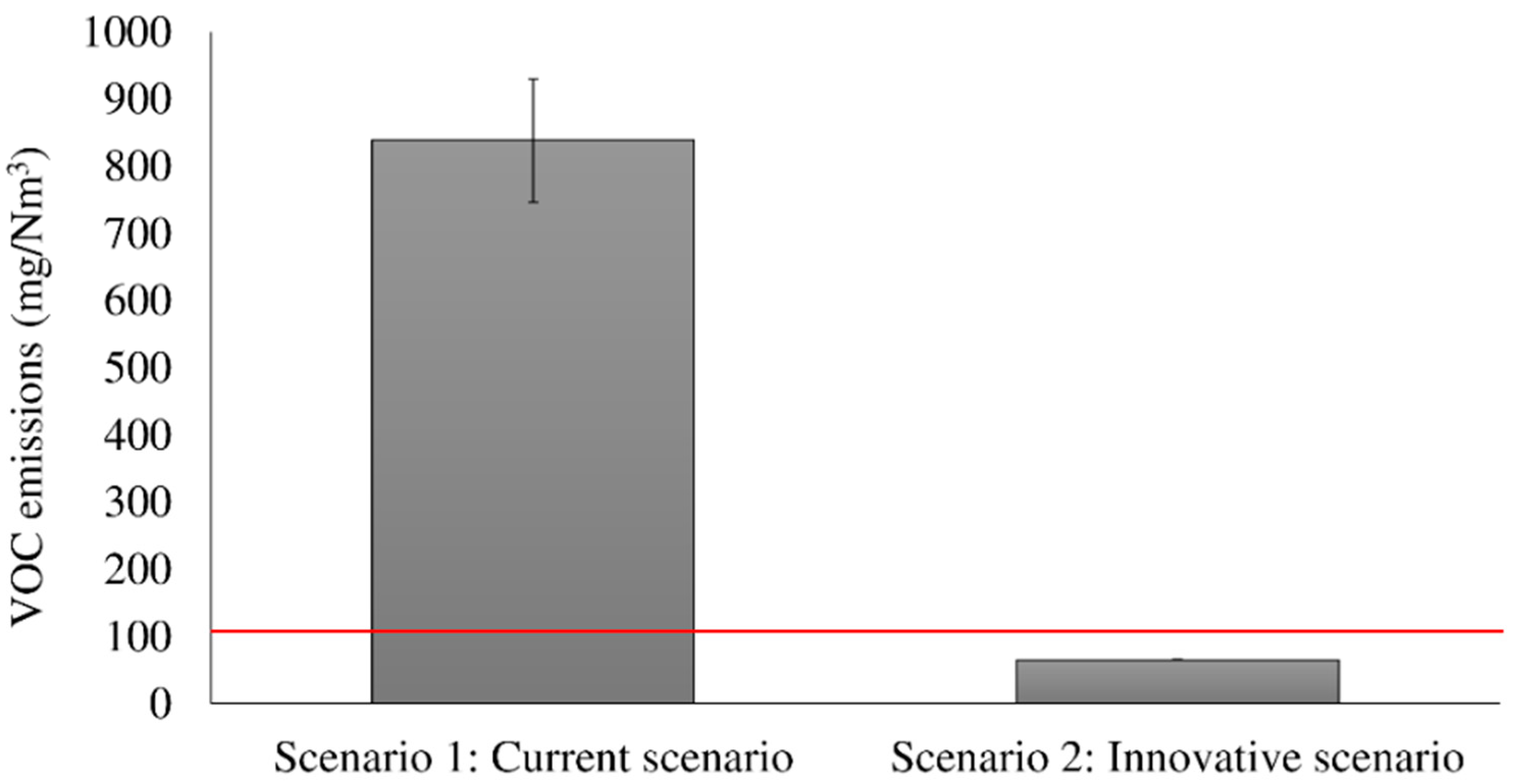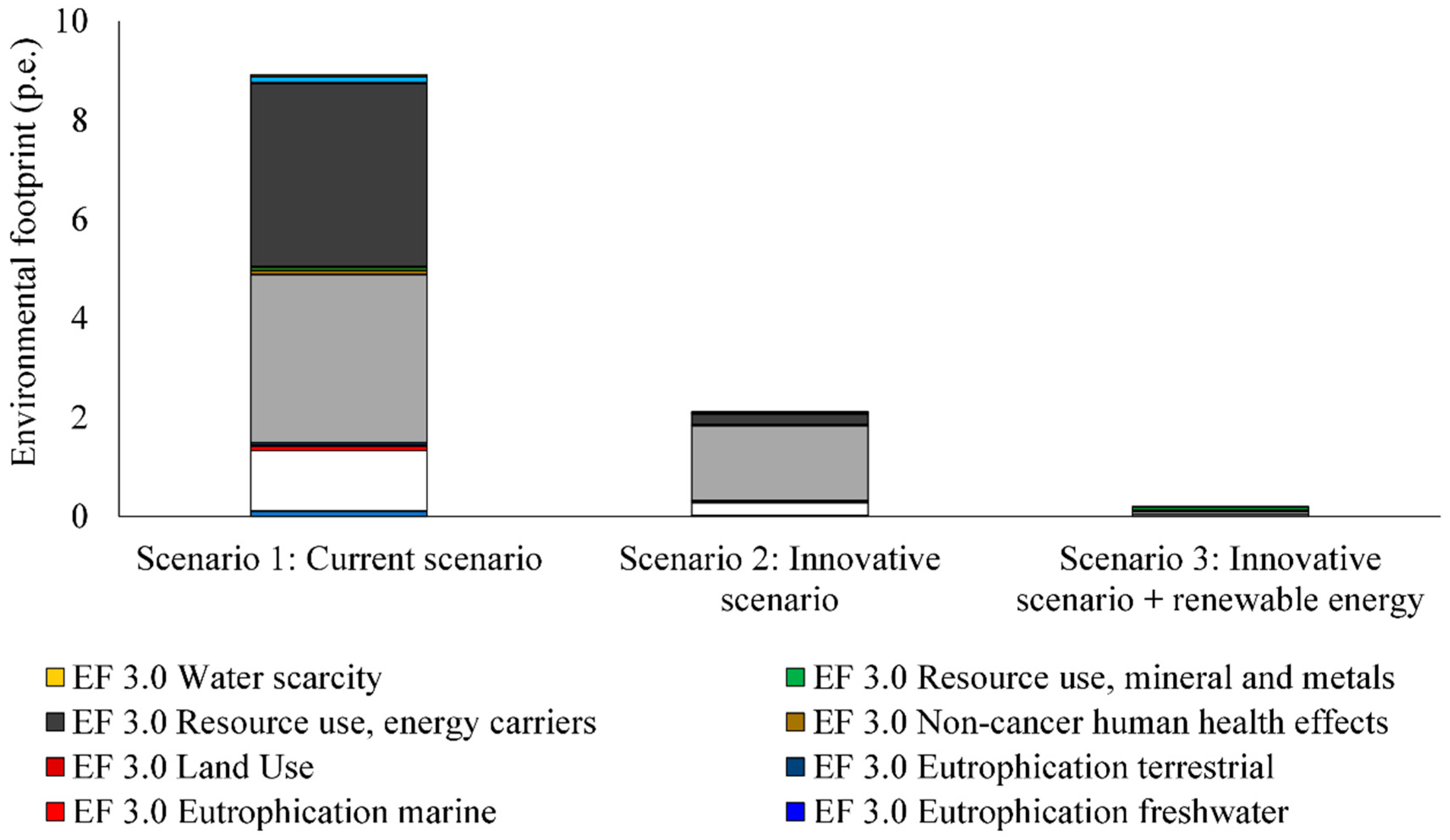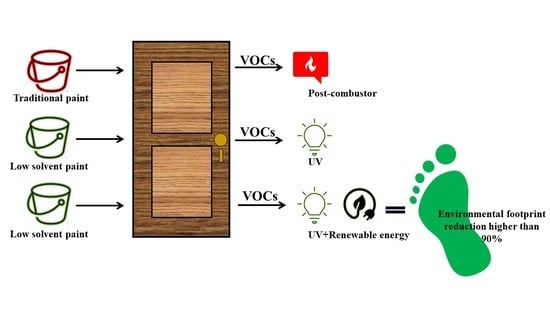Sustainable Reduction of the Odor Impact of Painting Wooden Products for Interior Design
Abstract
1. Introduction
2. Materials and Methods
2.1. Case Study Description
2.2. Emission Sampling
2.3. Environmental Sustainability Analysis
3. Results
3.1. Emission Abatement
3.2. Environmental Sustainability Analysis
4. Discussion
Author Contributions
Funding
Conflicts of Interest
References
- European Commission. Ecodesign Your Future: How Ecodesign Can Help the Environment by Making Products Smarter; European Commission: Brussels, Belgium, 2014; pp. 1–12. [Google Scholar]
- Euroepan Commission. A New Circular Economy Action Plan For a Cleaner and More Competitive Europe; European Commission: Brussels, Belgium, 2020; pp. 1–20. [Google Scholar]
- Baldinelli, G.; Asdrubali, F.; Baldassarri, C.; Bianchi, F.; D’Alessandro, F.; Schiavoni, S.; Basilicata, C. Energy and environmental performance optimization of a wooden window: A holistic approach. Energy Build. 2014, 79, 114–131. [Google Scholar] [CrossRef]
- Çinar, H. Eco-design and furniture: Environmental impacts of wood-based panels, surface and edge finishes. For. Prod. J. 2005, 55, 27–33. [Google Scholar]
- Knight, L.; Huff, M.; Stockhausen, J.I.; Ross, R.J. Comparing energy use and environmental emissions of reinforced wood doors and steel doors. For. Prod. J. 2005, 55, 48–52. [Google Scholar]
- Tong, R.; Zhang, L.; Yang, X.; Liu, J.; Zhou, P.; Li, J. Emission characteristics and probabilistic health risk of volatile organic compounds from solvents in wooden furniture manufacturing. J. Clean. Prod. 2019, 208, 1096–1108. [Google Scholar] [CrossRef]
- Wu, H.; Yan, H.; Quan, Y.; Zhao, H.; Jiang, N.; Yin, C. Recent progress and perspectives in biotrickling filters for VOCs and odorous gases treatment. J. Environ. Manag. 2018, 222, 409–419. [Google Scholar] [CrossRef] [PubMed]
- Balasubramanian, P.; Philip, L.; Murty Bhallamudi, S. Biotrickling filtration of complex pharmaceutical VOC emissions along with chloroform. Bioresour. Technol. 2012, 114, 149–159. [Google Scholar] [CrossRef]
- Morin, J.; Gandolfo, A.; Temime-Roussel, B.; Strekowski, R.; Brochard, G.; Bergé, V.; Gligorovski, S.; Wortham, H. Application of a mineral binder to reduce VOC emissions from indoor photocatalytic paints. Build. Environ. 2019, 156, 225–232. [Google Scholar] [CrossRef]
- Suzuki, N.; Nakaoka, H.; Hanazato, M.; Nakayama, Y.; Takaya, K.; Mori, C. Emission rates of substances from low-volatile-organic-compound paints. Int. J. Environ. Sci. Technol. 2019, 16, 4543–4550. [Google Scholar] [CrossRef]
- US EPA. Air Emissions Inventories-What Is the Definition of VOC. 2019. Available online: https://www.epa.gov/air-emissions-inventories/what-definition-voc (accessed on 16 November 2020).
- Zarra, T.; Galang, M.G.; Ballesteros, F.; Belgiorno, V.; Naddeo, V. Environmental odour management by artificial neural network—A review. Environ. Int. 2019, 133, 105189. [Google Scholar] [CrossRef]
- Brennan, B. Odour nuisance. Water Wastewater Treat 1993, 36, 30–33. [Google Scholar]
- Belgiorno, V.; Naddeo, V.; Zarra, T. Odour Impact Assessment Handbook; John Wiley & Sons: Hoboken, NJ, USA, 2013. [Google Scholar]
- Leonardos, G.; Kendall, D.; Barnard, N. Odor threshold determinations of 53 odorant chemicals. J. Air Pollut. Control. Assoc. 1969, 19, 91–95. [Google Scholar] [CrossRef]
- Brancher, M.; Griffiths, K.D.; Franco, D.; de Melo Lisboa, H. A review of odour impact criteria in selected countries around the world. Chemosphere 2017, 168, 1531–1570. [Google Scholar] [CrossRef] [PubMed]
- National Academy of Sciences. Odors from Stationary and Mobile Sources; National Academy of Sciences: Washington, DC, USA, 1979. [Google Scholar]
- Sarkar, U.; Longhurst, P.J.; Hobbs, S.E. Community modelling: A tool for correlating estimates of exposure with perception of odour from municipal solid waste (MSW) landfills. J. Environ. Manag. 2003, 68, 133–140. [Google Scholar] [CrossRef]
- Szczurek, A.; MacIejewska, M. Relationship between odour intensity assessed by human assessor and TGS sensor array response. Sens. Actuators B Chem. 2005, 106, 13–19. [Google Scholar] [CrossRef]
- Talaiekhozani, A.; Bagheri, M.; Goli, A.; Talaei Khoozani, M.R. An overview of principles of odor production, emission, and control methods in wastewater collection and treatment systems. J. Environ. Manag. 2016, 170, 186–206. [Google Scholar] [CrossRef]
- Liu, Y.; Lu, W.; Wang, H.; Huang, Q.; Gao, X. Odor impact assessment of trace sulfur compounds from working faces of landfills in Beijing, China, J. Environ. Manag. 2018, 220, 136–141. [Google Scholar] [CrossRef]
- Montecchio, F.; Bäbler, M.U.; Engvall, K. Development of an irradiation and kinetic model for UV processes in volatile organic compounds abatement applications. Chem. Eng. J. 2018, 348, 569–582. [Google Scholar] [CrossRef]
- European Commission. Directive (EU) 2016/2284 of the European parliament and of the council on the reduction of national emissions of certain atmospheric pollutants, amending Directive 2003/35/EC and repealing Directive 2001/81/EC. Off. J. Eur. Union. L 2016, 344, 1–31. [Google Scholar]
- European Commission. Directive 2001/81/EC on national emission ceilings for atmospheric pollutants. Off. J. Eur. Communities 2001, 309, 22–30. [Google Scholar]
- European Commission. Directive 2008/50/EC of the European Parliament and of the Council of 21 May 2008 on ambient air quality and cleaner air for Europe. Off. J. Eur. Union. 2008, 29, 169–212. [Google Scholar]
- Freitag, W.; Stoye, D. Paints, Coatings and Solvents; John Wiley & Sons: Hoboken, NJ, USA, 2008. [Google Scholar]
- Schieweck, A.; Bock, M.C. Emissions from low-VOC and zero-VOC paints—Valuable alternatives to conventional formulations also for use in sensitive environments. Build. Environ. 2015, 85, 243–252. [Google Scholar] [CrossRef]
- Krishnamurthy, A.; Adebayo, B.; Gelles, T.; Rownaghi, A.; Rezaei, F. Abatement of gaseous volatile organic compounds: A process perspective. Catal. Today 2020, 350, 100–119. [Google Scholar] [CrossRef]
- Laor, Y.; Parker, D.; Pagé, T. Measurement, prediction, and monitoring of odors in the environment: A critical review. Rev. Chem. Eng. 2014, 30, 139–166. [Google Scholar] [CrossRef]
- Maurer, D.L.; Koziel, J.A.; Harmon, J.D.; Hoff, S.J.; Rieck-Hinz, A.M.; Andersen, D.S. Summary of performance data for technologies to control gaseous, odor, and particulate emissions from livestock operations: Air management practices assessment tool (AMPAT). Data Br. 2016, 7, 1413–1429. [Google Scholar] [CrossRef] [PubMed]
- Buonicore, A.J.; Davis, W.T. Air Pollution Engineering Manual; Air and Waste Management Association: New York, NY, USA, 1992. [Google Scholar]
- Freudenthal, K.; Otterpohl, R.; Behrendt, J. Absorption of odourous substances using selective gas-liquid separation processes. Waste Manag. 2005, 25, 975–984. [Google Scholar] [CrossRef] [PubMed]
- Devinny, J.S.; Deshusses, M.A.; Webster, T.S. Biofiltration for air pollution control. Biofiltration for Air Pollution Control; CRC Press: Boca Raton, FL, USA, 1998. [Google Scholar]
- Ergas, S.J.; Càrdenas-Gonzàlez, B. Biofiltration: Past, present and future dictions. Biocycle 2004, 45, 35. [Google Scholar]
- Yilmaz, E.; Arslan, H.; Bideci, A. Environmental performance analysis of insulated composite facade panels using life cycle assessment (LCA). Constr Build. Mater. 2019, 202, 806–813. [Google Scholar] [CrossRef]
- Hollberg, A.; Ruth, J. LCA in architectural design—A parametric approach. Int. J. Life Cycle Assess. 2016, 21, 943–960. [Google Scholar] [CrossRef]
- Vilches, A.; Garcia-Martinez, A.; Sanchez-Montañes, B. Life cycle assessment (LCA) of building refurbishment: A literature review. Energy Build. 2017, 135, 286–301. [Google Scholar] [CrossRef]
- Hesser, F.; Wohner, B.; Meints, T.; Stern, T.; Windsperger, A. Integration of LCA in R&D by applying the concept of payback period: Case study of a modified multilayer wood parquet. Int. J. Life Cycle Assess. 2017, 22, 307–316. [Google Scholar] [CrossRef]
- Cobut, A.; Blanchet, P.; Beauregard, R. Prospects for Appearance Wood Products Ecodesign in the Context of Nonresidential Applications. For. Prod. J. 2016, 66, 196–210. [Google Scholar] [CrossRef]
- Frischknecht, R.; Braunschweig, A.; Hofstetter, P.; Suter, P. Human health damages due to ionising radiation in life cycle impact assessment. Environ. Impact Assess. Rev. 2000, 20, 159–189. [Google Scholar] [CrossRef]
- Amato, A.; Becci, A.; Birloaga, I.; De Michelis, I.; Ferella, F.; Innocenzi, V.; Ippolito, N.M.; Jimenez, C.P.; Vegliò, F.; Beolchini, F. Sustainability analysis of innovative technologies for the rare earth elements recovery. Renew. Sustain. Energy Rev. 2019, 106, 41–53. [Google Scholar] [CrossRef]




| Input Flow | Amount |
|---|---|
| Electricity consumption for door production with common paint (KWh) | 460 ± 90 |
| Electricity consumption for door production with innovative paint (KWh) | 240 ± 10 |
| Average methane consumption of post-combustor (m3) | 600 ± 300 |
Publisher’s Note: MDPI stays neutral with regard to jurisdictional claims in published maps and institutional affiliations. |
© 2020 by the authors. Licensee MDPI, Basel, Switzerland. This article is an open access article distributed under the terms and conditions of the Creative Commons Attribution (CC BY) license (http://creativecommons.org/licenses/by/4.0/).
Share and Cite
Amato, A.; Bigi, G.P.; Baldini, C.; Beolchini, F. Sustainable Reduction of the Odor Impact of Painting Wooden Products for Interior Design. Appl. Sci. 2020, 10, 8124. https://doi.org/10.3390/app10228124
Amato A, Bigi GP, Baldini C, Beolchini F. Sustainable Reduction of the Odor Impact of Painting Wooden Products for Interior Design. Applied Sciences. 2020; 10(22):8124. https://doi.org/10.3390/app10228124
Chicago/Turabian StyleAmato, Alessia, Gabriele Pietro Bigi, Cristina Baldini, and Francesca Beolchini. 2020. "Sustainable Reduction of the Odor Impact of Painting Wooden Products for Interior Design" Applied Sciences 10, no. 22: 8124. https://doi.org/10.3390/app10228124
APA StyleAmato, A., Bigi, G. P., Baldini, C., & Beolchini, F. (2020). Sustainable Reduction of the Odor Impact of Painting Wooden Products for Interior Design. Applied Sciences, 10(22), 8124. https://doi.org/10.3390/app10228124







